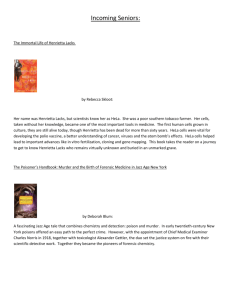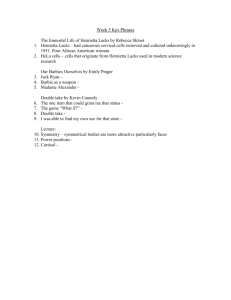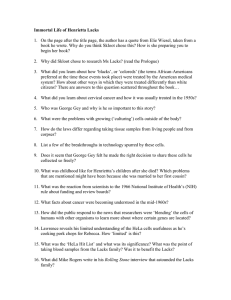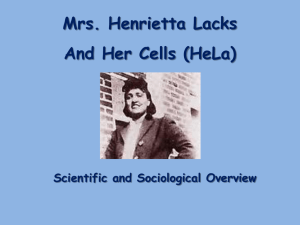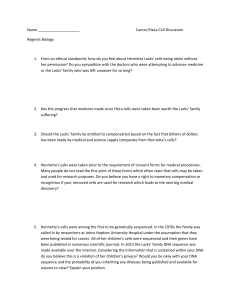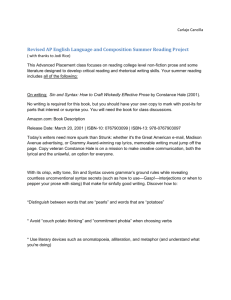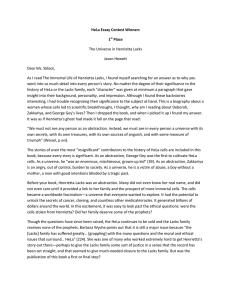BI 112: CELL BIOLOGY FOR HEALTH OCCUPATIONS
advertisement
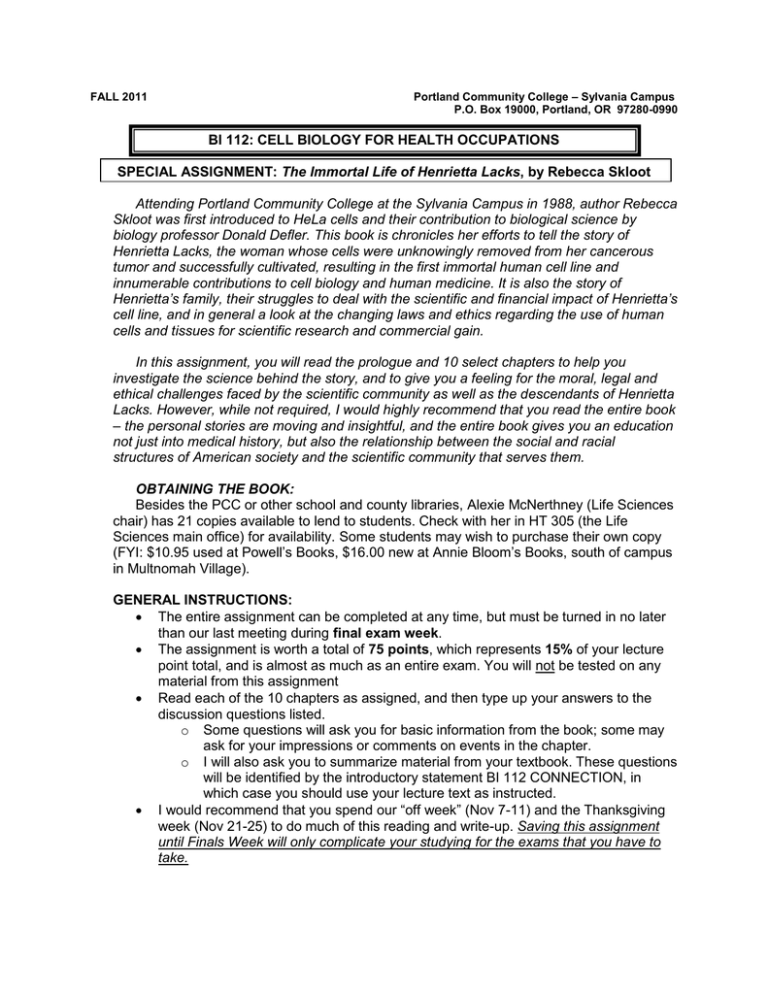
FALL 2011 Portland Community College – Sylvania Campus P.O. Box 19000, Portland, OR 97280-0990 BI 112: CELL BIOLOGY FOR HEALTH OCCUPATIONS SPECIAL ASSIGNMENT: The Immortal Life of Henrietta Lacks, by Rebecca Skloot Attending Portland Community College at the Sylvania Campus in 1988, author Rebecca Skloot was first introduced to HeLa cells and their contribution to biological science by biology professor Donald Defler. This book is chronicles her efforts to tell the story of Henrietta Lacks, the woman whose cells were unknowingly removed from her cancerous tumor and successfully cultivated, resulting in the first immortal human cell line and innumerable contributions to cell biology and human medicine. It is also the story of Henrietta’s family, their struggles to deal with the scientific and financial impact of Henrietta’s cell line, and in general a look at the changing laws and ethics regarding the use of human cells and tissues for scientific research and commercial gain. In this assignment, you will read the prologue and 10 select chapters to help you investigate the science behind the story, and to give you a feeling for the moral, legal and ethical challenges faced by the scientific community as well as the descendants of Henrietta Lacks. However, while not required, I would highly recommend that you read the entire book – the personal stories are moving and insightful, and the entire book gives you an education not just into medical history, but also the relationship between the social and racial structures of American society and the scientific community that serves them. OBTAINING THE BOOK: Besides the PCC or other school and county libraries, Alexie McNerthney (Life Sciences chair) has 21 copies available to lend to students. Check with her in HT 305 (the Life Sciences main office) for availability. Some students may wish to purchase their own copy (FYI: $10.95 used at Powell’s Books, $16.00 new at Annie Bloom’s Books, south of campus in Multnomah Village). GENERAL INSTRUCTIONS: The entire assignment can be completed at any time, but must be turned in no later than our last meeting during final exam week. The assignment is worth a total of 75 points, which represents 15% of your lecture point total, and is almost as much as an entire exam. You will not be tested on any material from this assignment Read each of the 10 chapters as assigned, and then type up your answers to the discussion questions listed. o Some questions will ask you for basic information from the book; some may ask for your impressions or comments on events in the chapter. o I will also ask you to summarize material from your textbook. These questions will be identified by the introductory statement BI 112 CONNECTION, in which case you should use your lecture text as instructed. I would recommend that you spend our “off week” (Nov 7-11) and the Thanksgiving week (Nov 21-25) to do much of this reading and write-up. Saving this assignment until Finals Week will only complicate your studying for the exams that you have to take. BI 112 SPECIAL ASSIGNMENT CHAPTER QUESTIONS The Immortal Life of Henrietta Lacks, by Rebecca Skloot CHAPTER ASSIGNMENTS: As stated earlier, I recommend reading the book in its entirety to fully appreciate it. But for your points in BI 112, read these chapters and type up your responses to the questions I have listed below. For “BI 112 CONNECTION” questions, the chapters refer to your lecture text book. The Extra Credit assignment is optional, but a worthy reflection on the ethics regarding experimentation on human tissues. PROLOGUE: The Woman in the Photograph CHAPTER 3: Diagnosis and Treatment o What type of cancer was Henrietta Lacks diagnosed with? Describe the two versions. o In the middle of the 20th century, doctors had very different attitudes towards using patients for research than they do today. Discuss the attitude at Johns Hopkins Medical Center in 1950, particularly in regards to patients at the public ward. o What is an “immortal human cell line” and why was it considered desirable for research? CHAPTER 4: The Birth of HeLa o Before the cultivation of HeLa cells, what were two major obstacles to growing cells in culture? Describe efforts to eliminate these problems. o How fast did the HeLa cell line grow once it was established? CHAPTER 7: The Death and Life of Cell Culture o What did George Gey do with HeLa cells once he had a successful cell line growing? CHAPTER 13: The HeLa Factory o Discuss how Jonas Salk’s discovery of the polio vaccine in 1952 led to the establishment of a large-scale production of the HeLa cell line. o At the Tuskegee Institute, how many HeLa cell cultures (and cells) were being produced once they reached peak production? o Discuss the role of the establishment of Microbiological Associates in the spread of HeLa cells in research. How did Microbiological Associates benefit? o This chapter discusses many ways in which HeLa cells were used in important biological research. Summarize the medical and cell research for which HeLa proved useful. CHAPTER 17: Illegal, Immoral, and Deplorable o Describe virologist Chester Southams’s research, begun in 1954, involving the injection of HeLa cells into patients and volunteers. o What is the “Nuremberg Code” and what was its origin? o Discuss how Southam’s research violated the legal concept of “informed consent” discussed on p. 132. CHAPTER 20: The HeLa Bomb o What was the “technical problem” that announced by Stanley Gartler in 1966? o Why did concern over the “HeLa Bomb” lead to scientists contacting the descendants of Henrietta Lacks in an attempt to obtain more cell and DNA samples? o BI 112 CONNECTION: Chapter 17, p. 335-336: DNA Analysis. (Refer also to page 328, “Gel electrophoresis…”). Read about restriction maps of DNA. Define “RFLP” and summarize how analysis of RFLPs are used in DNA fingerprinting 2 BI 112 SPECIAL ASSIGNMENT CHAPTER QUESTIONS CHAPTER 21: Night Doctors along with CHAPTER 6: “Lady’s on the Phone” o In Ch. 6: Based on Ms. Skloot’s discussion with Dr. Pattillo, describe the Tuskegee Syphilis Studies. o What other experiences of the Lacks family with Johns Hopkins contributed to their distrust of the institution and researchers there? CHAPTER 22: “The Fame She So Richly Deserves” o Describe the fate of Dr. George Gey, and how this led to Henrietta’s Lacks name being first published as the source of HeLa cells. o What role did Walter Nelson-Rees play in getting Henrietta’s name in the public eye? CHAPTER 27: The Secret of Immortality o What was German virologist Harald zur Hausen’s 1984 discovery about HeLa cells and Henrietta’s original disease? o How does the Human Papilloma Virus (HPV) work? How did it give Henrietta Lacks cancer? o Describe the role of HeLa research in uncovering information about the AIDS virus. o BI 112 CONNECTION: Chapter 10, p. 202-203: Describe the “p53” gene, and summarize how it works. Chapter 14: Define “telomerase”; describe how it was responsible for the immortality of HeLa cell lines. CHAPTER 32: “All That’s My Mother” Henrietta Lacks’ daughter Deborah and youngest son Zakariyya finally get to visit a lab using their mother’s cell line. o Dr. Christoph Lengauer gave the author and the two family members a tour of his lab, and helped dispel several misconceptions held by the family. Summarize a few of the things that he taught them about Henrietta’s cells and the HeLa cell line. AFTERWORD: (Optional - 5 pts Extra Credit) Rebecca Skloot notes two major ethical issues that to a large degree still need to be resolved: the issue of consent (should patients be informed if and how their tissue is being used in research? Should patients give permission?) and money (who owns cells and tissues? Who should profit from their use in science?). Read the afterword (also Chapter 25: “Who Told You You Could Sell My Spleen?” is very informative) and provide your reactions and responses to these question in particular: Should hospitals be required to obtain patient consent to take and use tissues in all circumstances? Do all citizens have an obligation to help medical research? Do you think consent should be obtained in all cases, or just for certain experiments? Who owns tissues and organs? If your cells or DNA lead to a major discovery with financial implications, who should profit? The person or the researcher? Should patients be told that their cells or DNA may lead to potential financial benefits? 3
